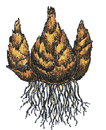Give Your Bulbs a Little Room
Now’s the time to uncrowd spring flowers

After daffodils have been growing in clumps for eight to 10 years, the plants in the middle of each clump become smaller than those along the outside edge. Older bulbs are being crowded by younger bulbs, and there is more competition for water, nutrients and light.
To keep your spring flowering bulbs in a healthy, vigorous condition and to expand your plantings, dig and divide the bulbs when the clumps become too crowded.
Do not, however, dig the bulbs for at least two to three weeks after all of the foliage has turned brown and died to the ground. To harvest the largest number of bulbs, remove all seed capsules as they form, shortly after the petals fall. By removing the seed capsules, you transfer the energy produced by the foliage back into the bulbs. Remove only the seed capsule — not the stem supporting it. The stem supporting the seed capsule is actually a round, photosynthesizing leaf.
After all of the foliage has completely dried down to the ground, begin digging, using a forked digging spade and starting at least four inches from the ring of dead foliage. You will find that the bulbs are much deeper than originally planted. That’s because bulbs have contractile roots that literally pull them deeper into the ground every year. Your intention is to lift the bulbs from beneath, so dig deep enough to get underneath the clump.
Shake as much loose soil from the bulbs as possible, but do not pry them apart. Allow the bulbs to dry in the sun for two to three days, or until all of the soil can be shaken from each bulb. Avoid removing the papery skin, called the tunic, which protects the bulbs from drying out.
After the bulbs have been cleaned, allow them to cure in a cool, dry, shaded, area for at least two weeks. The bulbs can now be separated, dusted with Captan five percent dust and stored in coarse woven bags such as those used for packaging onions. Protect the bulbs from rodents, and store them in a cool, dry, dark location until next September when bulb-planting season begins.
A Question of Natural Security
Q I’m seeking your advice on national security … err, natural security. I’d like to plant something thorny, yet fragrant, in front of my basement windows to deter unwelcome entrance. The spot I’m planning is on the south side of the house behind a large lilac and cornered by a fence. Shadows start getting cast on this spot around 3pm, so I may be conservative with my estimate of five to six hours of sun. My first thought is roses, which raises the question of hybrid, tea or shrub? Do certain species have stronger thorns? How much sun is required to keep roses healthy?
A If you’re right about only five to six hours of sun, you will have mildew and black spot problems with roses. For that amount of sun, I suggest Juliana barberry, which has thorns longer and denser than any rose’s. Furthermore, it has no disease or insect problem.